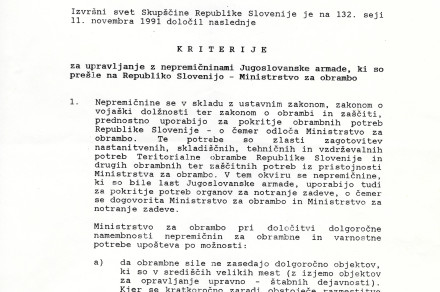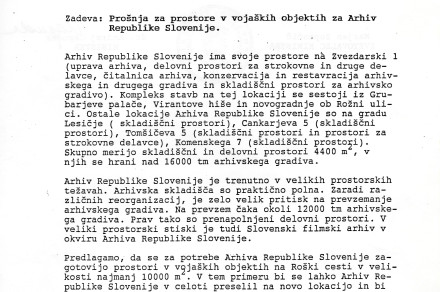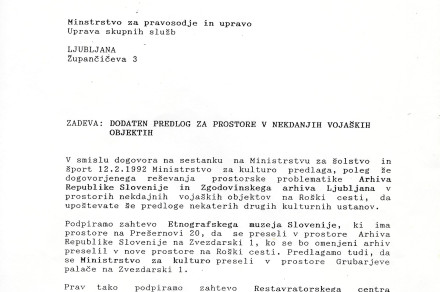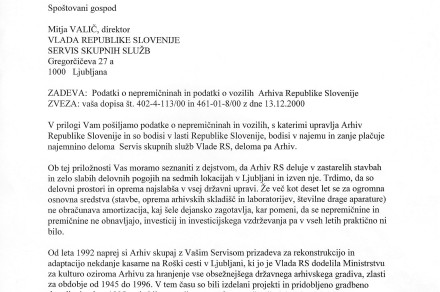Renovation of the Former Barracks on Roška or Poljanska Street for the Needs of the Archives of the Republic of Slovenia
Ljubljana, 1991−1992, 2000
Original, copies, paper, 5 documents, 11 pages
Reference code: SI AS 2198, Republiški sekretariat za kulturo RS, šk. 206, p. e. 4714; SI AS 2170, Arhiv Republike Slovenije, šk. 106, p. e. 4375
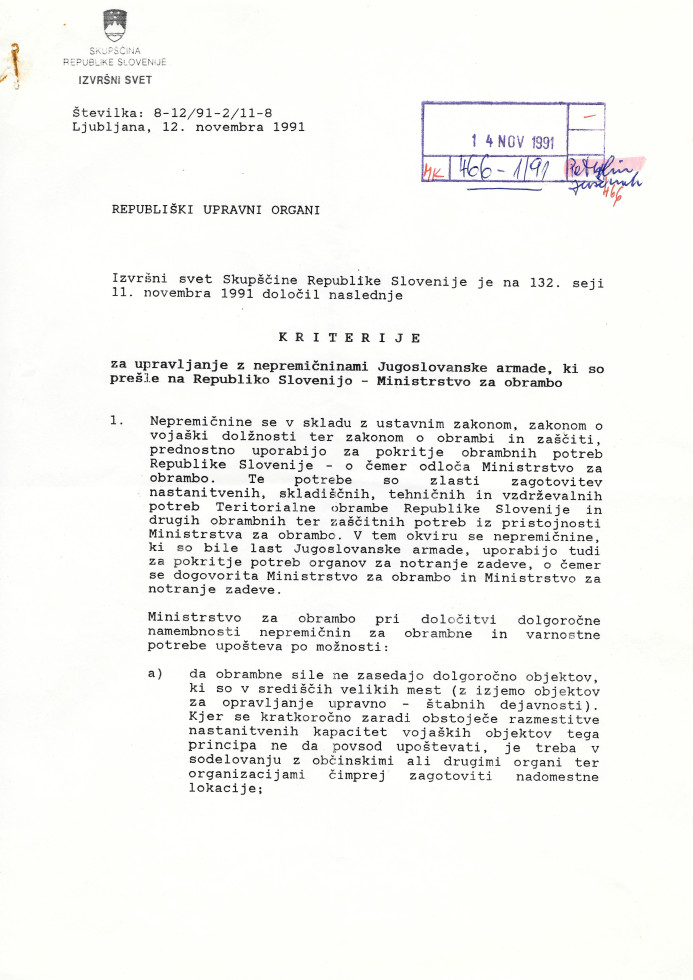
Criteria for the Management of the Real Estate of the Yugoslav Army that was Transferred to the Republic of Slovenia – Ministry of the Defence, November 12, 1991 | Author Arhiv Republike Slovenije, SI AS 2198, šk. 206, p. e. 4714
In mid-October 2024, the Archives of the Republic of Slovenia achieved its decades long ambition when it relocated to the renovated central wing of the former barracks on Roška or Poljanska Street and was finally able to house most of its spaces for its various activities under one roof.
Let us first start with a few words about the history of the building. The construction of the so-called Imperial-Royal Home-Guard Barracks for the 27th Home-Guard Infantry Regiment (also called Home-Guard Barracks or Roška Barracks, in German Kaiserlich-königliche Landwehr-Kaserne) began in 1891. The construction of its first phase was completed within a year. The second phase was resumed after the 1895 massive earthquake in Ljubljana and was completed in 1899. Even though the second phase of the construction did not follow the original design, the two blocks formed a whole, whose architectural features made it stand out from other buildings within its surroundings. Externally, the two buildings did not give the impression of being intended for military use.
After the fall of the Austro-Hungarian Empire, the building was taken over by the new authorities and renamed King Peter’s Barracks. During the Second World War, Italian, German and Home-Guard units were stationed there. After the war, the barracks came into the hands of the Yugoslav People’s Army, which renamed it the Marshal Tito Barracks and used it for military purposes up until the gaining of Slovenia’s independence in 1991. The building became more known to the general public in 1988, during the military trial called Trial against the Four – Janez Janša, Ivan Borštner, David Tasić and Franci Zavrl – when Roška Street was during the trial flooded with demonstrators carrying banners and demanding the release of the four defendants and respect of human rights.
This month's archivalia paints a picture of the events related to the barracks in the post-independence period. The first documents mentioning the former barracks on Roška Street as a potential location for the Archives of the Republic of Slovenia, date back to the start of 1992. The basis for this was the document titled »Criteria for the Management of the Real Estate of the Yugoslav Army that was Transferred to the Republic of Slovenia – Ministry of the Defence«, issued by the Executive Council of the Assembly of the Republic of Slovenia at its 132nd session on November 11, 1991.
At its 18th session on September 3, 1992, the Government of the Republic of Slovenia assigned the premises of the former barracks to be managed and used by the Ministry of Culture and the Ministry of Education and Sport. Here we need to distinguish between the older part of the barracks complex along the Roška Street, where a secondary school centre came to life after it had been renovated, and the three-wing building complex located between Roška, Poljanska and Kapusova Street, which was built at a later stage, and which is the focus of this article. At its 114th session on November 17, 1994, the Government of the Republic of Slovenia decided that the building along the Poljanska Street (together with the land to be used for subsequent extension of the facility to accommodate archival repositories) was to be designated for the needs of the Archives of the Republic of Slovenia, the Restoration Centre of the Republic of Slovenia, and the Historical Archives Ljubljana. The office of the Joint Services for the Government was assigned to manage the investment of renovation.
In the summer of 1991, the barracks also became the first refugee reception centre in Ljubljana. During the war in Bosnia and Herzegovina, the centre accommodated as many as two thousand people, and was closed in 1995. That same year, the first phase of the construction was completed. Even though constant effort was put into it, the investment failed to move much further during the last decade of the previous century, despite the prediction stated in the original plans that the renovation of the complex would be finished by 1998. Instead, not even a building permit was obtained until 1999.
When replying to the inquiry conducted by the Joint Services of the Government of the RS regarding the Archives’s property and vehicles, the then Director of the Archives, Vladimir Žumer, gave a detailed answer dated December 19, 2000, which was a reflection of the situation that the Archives was experiencing at the time. Among other things, Vladimir Žumer in his letter stated: On this occasion I wish to inform you that the Archives of the Republic of Slovenia is currently operating in outdated buildings in very poor working conditions across seven locations in Ljubljana and outside it (Author’s note: in Ljubljana, these include the main location at Zvezdarska Street 1, as well as Cankarjeva Street 5, Kazina – Kongresni trg, Plava Laguna – Linhatrtova Street 1, and Petrol – Dunajska Street 48, with additional locations outside Ljubljana at Lisičje Castle – Lanišče 23 and Gotenica). We believe that our workplaces and equipment are the worst in the entire state administration. For more than a decade, no depreciation has been calculated for our huge fixed assets (buildings, equipment in archival repositories and laboratories, a number of other expensive apparatus), let alone actually provided, which means that real estate and immovable property are not being renewed, and investments and investment maintenance have been practically non-existent over the years.”
By 2006, apart from the western wing, which belonged to the Restauration Centre of the RS, only the eastern wing on Kapusova Street had been renovated to serve as repositories space for the state archives, with one floor being allocated for the use of the Historical Archives Ljubljana. Meanwhile, the northern (central) wing along the Poljanska Street, which was intended to eventually house the Archives of the RS’s offices, gradually fell into disrepair.
In May 2013, the Ministry of Culture and the Archives of the RS agreed in principle that the renovation of the central wing would allow the relocation of all the Archives' administrative offices and public programmes, leaving only repositories at the Zvezdarska Street 1 location. A phased renovation of the building was agreed upon; the first phase would involve the renovation and expansion of the central wing, and subsequent phases would allow for the construction of repositories and other spaces along the southern edge of the complex as well as a functional connection of all the wings.
After the project brief and conceptual design were approved, the Archives of the RS prepared the rest of the project documentation (building permit plans and implementation plans) needed for the renovation and expansion of the central wing. Because the building was protected as a cultural monument, the preparation of the needed documentation had to be done in close collaboration with the Institute for the Protection of Cultural Heritage of Slovenia. The renovation of the central wing of the building complex was also included in the National Programme for Culture as a basic strategic document in the field of culture and cultural heritage protection.
The building permit for the renovation and expansion of the central wing as well as the addition of a new structure in the courtyard was obtained in the summer of 2017. Another four years passed until October 2021, when the investment programme Reconstruction and Extension of the Building at Poljanska Street 40 in Ljubljana was eventually included in Development Programs Plan. A contract with contractors for construction, craftwork and installation works was signed in March 2022. In June 2024, the work was completed, and the Archives of the RS took over the building for use.
After the installation of technological and office interior equipment, all archival employees, part of archival holdings, and areas designated for archival visitors – such as archival reading room, lecture halls, exhibition space, and other – finally moved under one roof in September and October 2024.
This certainly is a positive foundation and a reason for celebration on the forthcoming 80th anniversary of the Archives of the RS.
Jernej Križaj
-
Decision of the Government of the Republic of Slovenia, adopted at its 18th session on September 3, 1992, on the allocation of the former barracks on Roška Street to be managed and made use of by the Ministry of Culture and the Ministry of Education and Sport.
-
Decision of the Government of the Republic of Slovenia, adopted at its 114th session on November 17, 1994, allocating the existing building of the former Home Guard barracks on Roška Street in Ljubljana, along with the land on which further construction of the building will be possible, for the use of the Archives of the Republic of Slovenia, the Restoration Centre of the Republic of Slovenia, and the Historical Archives Ljubljana.
- Marković, Zvezdan: Vojašnica na Roški v Ljubljani. V: Slovenska vojska, vol. 23, no. 8, August 2015, p. 46.
- Zabukovec, Mojca: Ljubljansko ogledalo: Se vam to zdi nekako znano? (Begunci v Ljubljani skozi dokumentacijo Dela: »Kakšnega spustijo v mesto tudi za nagrado«).


